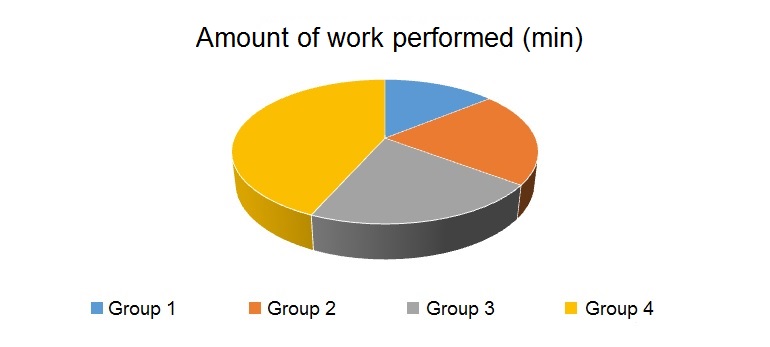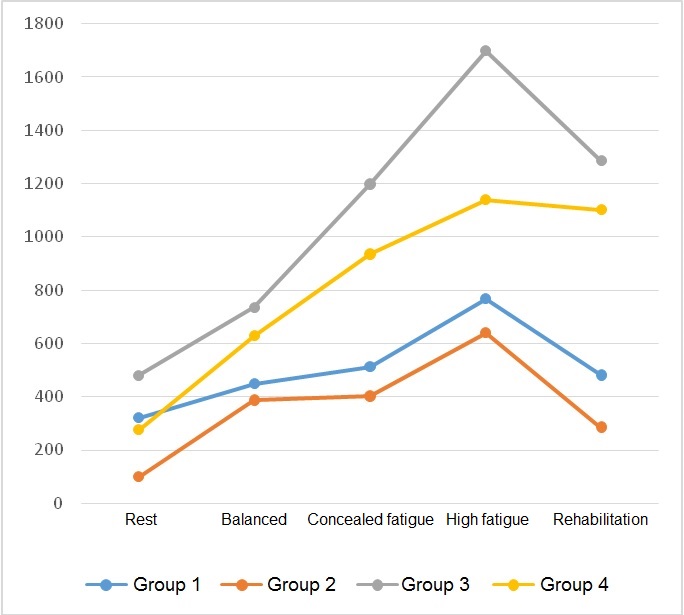Mental conditioning effects on glucoside activity in saliva in junior athletes physicality tests
ˑ:
Dr.Biol., Professor R.V. Tambovtseva1
I.A. Nikulina1
1Russian State University of Physical Education, Sports, Youth and Tourism (SCOLIPE), Moscow
Keywords: athletes, working capacity, glucoside activity in saliva, test load.
Introduction. Currently, modern living conditions are associated with a powerful effect of various stress factors that adversely affect the state of health; there is a decrease in the energy potential of the body, physical and mental working capacity. This problem affects all population strata, including athletes. At the same time, various regulatory mechanisms are overstressed, which leads to both physiological and biochemical maladaptation. To neutralize or suspend the detrimental course of this process, scientists are developing various means and methods that would help reign the influence of negative factors on the metabolic and functional resources of the body [1, 4, 5]. From the standpoint of a systemic approach, the process of adaptation is associated with the formation of the bodily functional reserves mobilization system. It is extremely important to expand the functional reserves of metabolic processes and transformation of the muscular activity energy. On the one hand, physical load is a stress factor, on the other, it can be considered an ergogenic tool that positively affects the functional state of the body, like other factors. Modern literature contains a sufficient number of works devoted to the effects of muscle tension and emotional stress on the gastrointestinal tract functioning, in particular on the secretion of digestive enzymes [2, 3, 7, 8]. The oral fluid contains various bioactive compounds, metabolites, enzymes, hormones, immunoglobulins, the concentration of which may vary depending on the endogenous and exogenous factors [2]. The problem of the impact of physical load and mental conditioning on the glucoside activity in the saliva of junior athletes seems quite relevant.
Objective of the study was to test effects of a positive mental conditioning on the glucoside activity in the saliva in the beginner junior athletes aged 16-17 years in standard trainings.
Methods and structure of the study. The study was carried out at the Muscular Activity Bioenergy Laboratory of the N.I. Volkov Sports Biochemistry and Bioenergy Department of Russian State University of Physical Education, Sports, Youth and Tourism. Sampled for the study were the 16-17 year-old low-class middle-distance runners (n=21). According to the medical examination, all subjects were apparently healthy, and they gave their informed consent for participation in the experiment. The subjects were tested with ergometric and biochemical tests, with the test data processed by a standard mathematical statistic toolkit. The subjects ran "Monark" cycle ergometer to failure at 70% of submaximal workload in the standard laboratory setting versus mentally conditioned trainings. We registered the retention time and workload, including the V.A. Tkachuk [6] glucoside activity in the saliva tests at rest, in training cycle and 5 min after the training.
Results and discussion. During the experiment, the low-skilled athletes were split into two groups by the amount of the test load performed. Moreover, under ordinary conditions, the total amount of work performed by one group was 20.8+0.94 min, and by the other - 31.2+1.03 min (p<0.01). Exactly the same picture was observed among the athletes after the positive mental conditioning: the workload was 31.6+0.78 min and 64.0+1.89 min in each group respectively. Moreover, the work performed under the influence of the positive mental conditioning significantly exceeded the amount of work performed under ordinary conditions (p<0.001) (Fig. 1).

Fig. 1. Amount of work (min) performed by the low-skilled athletes under ordinary conditions and under the influence of positive mental conditioning (Groups 1 and 2 — work performed under ordinary conditions; Groups 3 and 4 — work performed under the influence of positive mental conditioning).
When comparing the saliva glucoside activity values, it was found that in Group 1, which performed a small amount of work under ordinary conditions, it was within 321+60.3 amylolytic units (a.u.), and in Group 2, which performed a large amount of work under the same conditions, saliva glucoside activity decreased significantly and amounted to 100.7+13.4 a.u. (p<0.01). A similar picture was observed during the performance of the load under the influence of positive mental conditioning. However, saliva glucoside activity in these athletes was significantly higher than in those tested under ordinary conditions. It can be concluded that regardless of the test conditions - ordinary or after positive mental conditioning - the athletes with lower endurance skills, the initial saliva glucoside activity value is significantly higher than in those with higher endurance skills.
The analysis of the dynamics of saliva glucoside activity, which was determined at different stages of testing revealed that in a stable state - upon reaching the anaerobic threshold and its transition, as well as during the recovery period - in the group of athletes with lower endurance skills performing the load under ordinary conditions, the saliva glucoside activity values significantly increased at the moment of reaching the balanced state and onset of concealed fatigue, along with a further increase in activity during the development of high fatigue, and a sharp decrease during the 5th minute of rehabilitation. Just the same picture was observed among the athletes who performed work under the influence of the positive mental conditioning, with the only difference being that these indicators were significantly higher than those obtained without the use of mental conditioning. In other words, in this case an activating effect of the positive mental conditioning on the glucoside activity in the saliva is observed at all stages of the cycle ergometer testing (Fig. 2).
Fig. 2. Dynamics of glucoside activity in saliva in junior athletes during 70% submaximal workload under ordinary conditions and positive mental conditioning
Horizontal axis - stages of the experiment: rest, balanced state, concealed fatigue, high fatigue, rehabilitation (5 min).
Groups 1 and 2 - load performed under ordinary conditions.
Groups 3 and 4 - load performed under the influence of mental conditioning.
Vertical axis - the glucoside activity in saliva in amylolytic units (a.u.).
Therefore, it can be assumed that an increase in the glucoside activity in the saliva in response to the test load can be associated with saliva secretion reduced and saliva density increased on the one hand; and the protein ferments synthesis activation on the other hand, with the ferments disintegrating polysaccharides to produce energy for work. The process of protein ferments synthesis in the salivary glands is under the regulatory influence of motor-visceral reflexes. Apparently, the proprioreceptive impulses that arise during dynamic work have an activating effect on the synthetic activity of salivary gland cells, especially in terms of the positive metal conditioning. It can be assumed that the lower saliva glucoside activity values in the athletes who have performed more work is due to the fact that the impulse flow from the proprio- and enteroreceptors going to the cerebral cortex increases excitation in the motor analyzers, inducing deeper inhibitory processes in them, including in the salivary glands.
Conclusions. The saliva glucoside activity kinetics not only reflects the effects of muscle load and exogenous factor on the body of athletes as represented by the positive mental conditioning, but can also be one of the criteria of the athletes' endurance to muscle loads when working in different power zones.
References
- Volkov N.I., Voytenko Yu.L., Tambovtseva R.V., Dyshko B.A. Problemy ergogennykh sredstv i metodov trenirovki v teorii i praktike sporta vysshikh dostizheniy [Problems of Egogenous Methods and Techniques of Training in Theory and Practice of Elite Sport]. Teoriya i praktika fiz. kultury. 2013. no. 8. pp. 68-72.
- Kuznetsov A.P., Smelysheva L.N., Sazhina N.V. Fermentativnye vzaimootnosheniya pishchevaritelnykh zhelez pri deystvii myshechnogo i emotsionalnogo napryazheniya [Enzymatic relationship of digestive glands under muscle and emotional stress]. Vestnik KGU. 2008. no. 1. P. 29-36.
- Smelysheva L.N. Rol avtonomnoy nervnoy sistemy v regulyatsii zheludochnoy sekretsii v pokoe i v usloviyakh stressa [Role of autonomic nervous system in regulation of gastric secretion at rest and under stress]. Proc. XX Congress of I.P. Pavlov Physiological Society. Moscow, 2007. P. 422.
- Tambovtseva R.V., Voytenko Yu.L., Laptev A.I., Zhumaev O.S. Vliyanie minimalnykh doz ekzogennogo suktsinata ammoniya na pokazateli serdechno-sosudistoy i dykhatelnoy sistem v vosstanovitelnom periode posle nagruzki aerobnogo kharaktera [Effects of exogenous ammonium succinate in minor doses on athletes' cardiovascular and respiratory systems during recovery after aerobic exercise]. Teoriya i praktika fiz. kultury. 2017. no. 5. pp. 62-64.
- Tambovtseva R.V., Orel V.R. Vliyanie drobnogo dykhaniya na gemodinamicheskie effekty luchnikov v period vosstanovleniya [Fractional breathing impact on haemodynamic effects of archers in recovery period]. Teoriya i praktika fizicheskoy kultury. 2017. no. 3. pp. 23-25.
- Tkachuk V.A. Klinicheskaya biokhimiya [Clinical biochemistry]. Moscow: Meditsina publ., 2004. 515 p.
- Kaye J., Kendrick A., Johnson P., Lowry C., Bailey J., Nutt D., Lightman S. Acute carbon dioxide exposure in healthy adults: Evaluation of a novel means of a novel means of investigation the stress response. J. Neuroendocrinol. 2004. 16, no. 3. pp. 256-264.
- Maton P.N. Prevention of stress-related mucosal bleeding with proton-pump inhibitors. Alim. Pharmacol. and Ther. 2005. 22. pp.45-52.
Corresponding author: ritta7@mail.ru
Abstract
Objective of the study was to test effects of a positive mental conditioning on the glucoside activity in the saliva in the beginner junior athletes in standard trainings versus mentally conditioned trainings. Sampled for the study were the 16-17 year-old middle-distance runners (n=21) tested with ergometric and biochemical tests, with the test data processed by a standard mathematical statistics toolkit. The subjects run Monark cycle ergometer at 70% submaximal workload in the standard trainings versus mentally conditioned trainings, with the workload and endurance tests, and with the V.A. Tkachuk glucoside activity in the saliva tests at rest, in the training cycle and 5min after the training. The tests found the positive mental conditioning being of stimulating effect on the glucoside activity in the saliva at every stage of the cycle ergometer test (including the balanced stage, concealed fatigue stage, high fatigue stage and rehabilitation stage), with saliva secretion reduced and saliva density increased on the one hand; and the protein ferments synthesis activation on the other hand, with the ferments disintegrating polysaccharides to produce energy for work.



